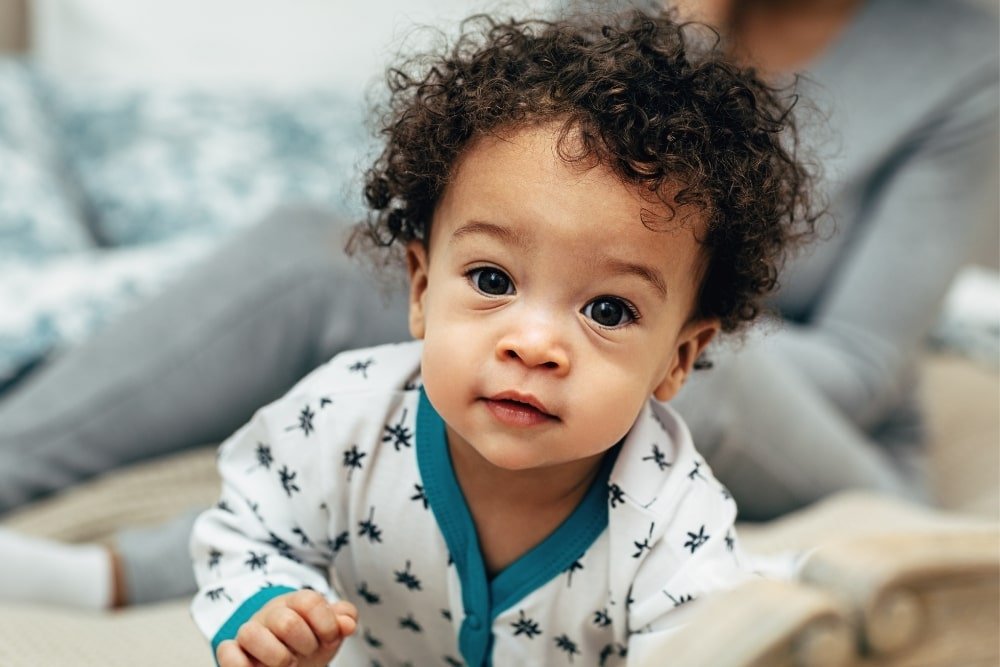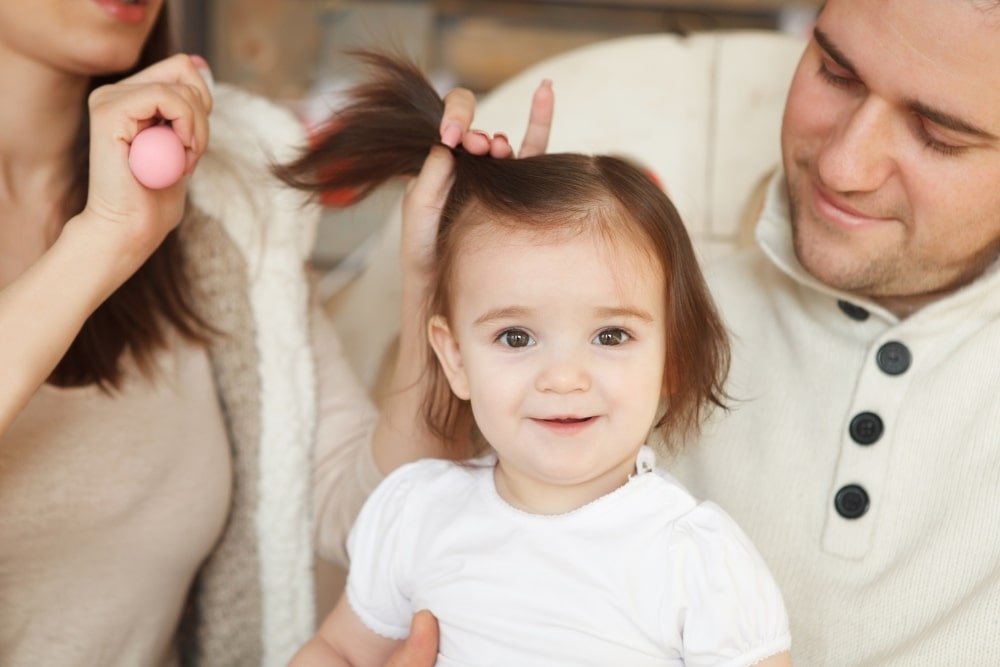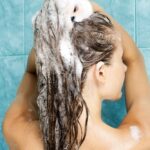The love a parent has for their baby certainly doesn’t come down to how much hair they have on their tiny head. But, it’s natural to wonder how much hair your little one should, or, could potentially have.
Some babies are naturally born with a head thick with hair or lots of thin hair.
One of the first things I hear parents talk about newborn babies is how much hair they have! Many parents talk about the color, length, and thickness of their own children’s hair.
Directly after birth, babies have a head of hair. Some of which they might lose overtime naturally. Features like your baby’s eyes, teeth, and hair rapidly change in the first year. In a sense, hair growth or loss is a baby’s first big milestone.
If a baby is born with a head of hair, the guessing game begins. How much more it will grow? How much they will lose?
If a baby is born nearly bald, relatives love to predict joyfully how much hair their baby will grow in the time to come.
How much hair babies will grow is super fascinating for those around them. From the time of their first hair cut to the first ponytails, it becomes a part of family discussions for those who love them.
When I was still pregnant, I remember some of the first dreams I had of each of my babies were of how hairy or not they would potentially be.
Here are the top 10 ways that parents can encourage healthy hair for their own baby. These are the top tips other parents swear by to make your baby hair grow faster, thicker, and stronger.
In this article
- Introduce Essential Vitamins for Baby Hair Growth
- Practical Measures for the Best Scalp Care
- Establish An Oil Wash Routine
- Eliminate Cradle Cap
- Sea Gelatin for Hair Growth
- Use Gentle Hair Accessories on Baby Hair
- Check For Curls or Knots in Baby Hair
- Use Organic Hair Care Products When You Can Manage
- Heat Causes Irreversible Hair Damage
- Butter Creme and Shea Butter
- Trim Groom and Protective Hairstyles
- Check for Underlying Medical Conditions If Necessary
- Conclusion
- Sources
Introduce Essential Vitamins for Baby Hair Growth
Babies get their vitamins from their mother’s breast milk until they can eat solid foods. At about 6 months of age, it becomes even more important that they’re getting a variety of fresh fruits and vegetables.
For a baby to have optimal hair health, it depends on proper vitamins and nutrients being introduced in their diet for children under the age of 2.
Once a baby is 2 years and up, lots of companies have multivitamins made specifically for hair growth. While these vitamins focus mostly on a properly functioning immune system, this gives you a little insight in regards to what makes a head of healthy hair.
View in gallery
The immune system! Having adequate vitamin C, Vitamin E, and Iron all play a significant role in how a baby’s hair will grow.
If a child doesn’t have a healthy immune system and is constantly working to fight off colds and illness, their bodies will be focused on that rather than growing hair.
Baby foods that are rich in iron
- Tofu
- Eggs
- Black beans and other legumes
- Chicken, turkey, or fish
- Iron-fortified baby formula
Baby foods that are rich in Vitamin C
- Broccoli
- Peppers
- Sprouts
- Kiwi, peaches, and berries
- Cabbage and sweet potatoes
Baby foods that are rich in Vitamin E
- Carrot juice
- Almond oil
Once your baby is able to have solid foods, it’s worth getting them off to a good start that supports healthy hair growth. While still breastfeeding mothers can aim to get a good supply of vitamins that help nourish their infants through their milk.
At about 2 years of age, you’re welcome to begin giving your baby a vitamin geared towards hair growth and overall health. Nutrition and having sufficient vitamins within the body are key for babies to growing healthy hair.
Practical Measures for the Best Scalp Care
On the outside, it’s more about taking care of your baby’s scalp. But, many parents don’t know where to start or even what a healthy scalp requires to function the way it’s meant to. An infant’s scalp needs to stay clean and moisturized.
View in gallery
Oiling your baby’s hair
Applying high-quality oils regularly to your infant’s scalp will keep the grime off their head, encourage hair growth, and introduce deep moisture to your baby’s locks. Coconut or virgin olive oil will work best for this job.
Not only is it soothing for your baby to get a head massage, but it gives time for parents to connect with their babies.
Apply as much or little oil is needed to cover the head, then massage it for a few minutes. Doing so brings circulation and blood flow to the region further encouraging hair to grow.
After you’re done massaging, you can gently run a comb through it and wipe off any excess oil.
Establish An Oil Wash Routine
Aim to oil your baby’s hair for 2 days in a row, then wash with a gentle shampoo every 3rd day. Washing anyone’s hair too often will dry it out and cause damage.
How to wash baby hair
- Wet the head with lukewarm water
- Drop a small amount of baby-friendly shampoo on the top of their head.
- Rub it around gently on top, moving it towards the ends of their hair.
- Ask baby to look into your eyes or at the sky, even as young infants warming them up to this language and doing their part pays off eventually. Talking to your baby during a bath soothes them.
- Rinse hair thoroughly with lukewarm water that is comfortable for their skin.
To dry don’t rub it with a towel, place a towel around their shoulder and pat dry any hair they have. Allowing it to mostly air dry. Rubbing baby hair with a towel can pull out hair unnecessarily.
If it’s a sunny day, pop outside after a bath and apply a bit of oil to their hair once it’s dry in the sunshine.
Eliminate Cradle Cap
If your baby has a cradle cap, you’ll likely notice dry yellow gunk on top of their head. It’s often a mixture of dry skin, dirt, and an overproduction of oils from the scalp attempting to correct it on its own.
View in gallery
Many babies get cradle cap. Though it is harmless, hair growth can be significantly hindered because of it. It will occur sometime a few weeks after birth and can last well into toddler years if it isn’t taking care of properly.
It can cause hair to grow more slowly, cause itchiness, and look quite unsightly the worse it gets. To eliminate the cradle cap, you’ll need to apply a bit of oil and gently comb out the gunk and skin flakes that are built up on top of the head.
After a wash, it’ll be easier to notice the dry flakes falling off as you comb through it, but be sure to apply a bit of oil if they just had a wash to not further irritate the scalp or cause scratches to the delicate skin.
After wiping away any skin flakes or grime stuck to your baby’s head, wipe it away or pick it out like a mamma chimpanzee. Whatever feels most natural to you!
It should subside in a few sessions of care but will return if it’s not managed after eliminating it. Encourage regular bathing and washing routines as your baby reaches toddler years to prevent build up on the scalp as your child gets older.
Sea Gelatin for Hair Growth
Gelatin is a substance that softens hair follicles while strengthening all parts of existing hair. People have long used gelatin to make their hair beautiful and lush. Now you can use the sea version of it on your little one’s head!
Agar-Agar is basically the vegan sea version of gelatin. It’s much easier to obtain and less harmful to use in regards to the eco-system. It’s derived from plants instead of animals!
Another benefit of using agar is that 1 teaspoon of agar powder is equal to 8 teaspoons of gelatin. You can find it online anywhere, and it’s easy to store for years.
How to prepare agar for baby hair
- Mix one tablespoon of agar with hot (not boiling) water.
- Once cool apply it to the scalp.
- Rinse off after 20-30 minutes.
- Cleanse hair with gentle baby shampoo.
- Apply a bit of coconut oil to hair as a deep conditioner.
You can do this once every few months. Be sure not to overly use agar or gelatin for hair care. It’s a protein treatment. If you do it too often, you could reap negative effects rather than positive benefits.
Be gentle with your baby’s hair and the head, as it is crucial to promote hair growth. Tying it up in a ponytail that’s too tight can cause unnoticed breakage that only stands out over time.
Up Do’s
Even though those buns and pigtails are super adorable, for the first few years at least, it might be best to let the hair fall free or use soft clips to keep it from hanging in the eyes.
Microfiber hair towels
When drying, allow it to air dry as often as possible in the warmer months, instead of rubbing with any towels. Microfiber hair towels are a great option for absorbing any moisture from the bath in the winter months.
These towels are lighter and more efficient than cotton towels. They are built to wrap just around the head instead and aren’t big like a full-body towel.
If your child pulls on their hair
If your child has a habit of fidgeting with their own hair as they become older, encourage them to leave their hair alone or tug at their baby doll hair instead.
If this habit is not eliminated, you might find your find that your 5-year-old therapeutically tugs at their hair for comfort. This causes breaking and significant damage as time goes on.
Use Gentle Hair Accessories on Baby Hair
Hair accessories that are meant for infants or small babies are important. Even headbands that have rough materials can cause damage to delicate hair.
- Handmade ribbon lined alligator baby hair clips
- Embellished using non-toxic glues
- Clip base measures approximately 3.5 cm/1.4
- Fits 0-6 years best
- Includes 8 hair clips
Prices pulled from the Amazon Product Advertising API on:
Product prices and availability are accurate as of the date/time indicated and are subject to change. Any price and availability information displayed on [relevant Amazon Site(s), as applicable] at the time of purchase will apply to the purchase of this product.
If you notice that certain hair accessory tugs or pulls out any strands of hair when you remove it, discontinue using it.
When choosing rubber bands for baby hair, opt for the ‘no damage hair bands’ that are intended for hair that breaks easily. You can find these online, instead of settling for the tiny rubber bands in your local grocery store.
It’s worth the time and investment of ordering them online to keep your little one’s hair from breaking over time. Seamless no damage hairbands are best!
Check For Curls or Knots in Baby Hair
If you ask any parent how quickly knots form in their children’s hair, you would be surprised! One day their hair is combed through, you miss one bath routine, and then the knots start to appear!
View in gallery
They might be small, at first, but they take off quickly. One small section of “curls” or knots will rapidly suck in surrounding hair.
You need to catch them when they first start if you want to keep your infant’s hair free of tangles, especially on the back of their head where it’s constantly rubbing against car seats and bedding.
It isn’t unusual for baby hair to bunch up, and rub off the back of the head when they are a few months old. You can’t really help the bald spot they might form from rubbing, but if you see tangles it’ll help to work them out as soon as they form.
Use Organic Hair Care Products When You Can Manage
Organic, and gentle hair products are best for small babies. Many hair care products on the market have added dyes, harmful preservatives, and other chemicals that are very harsh on hair.
When buying your baby’s hair products, consider using 100% organic formulations to avoid these.
Chemicals like formaldehyde have been found in non-organic baby shampoos which can cause skin irritations and rashes. Hair can break easily once it’s been damaged by chemicals.
All-natural or organic baby shampoos are available in local grocery stores – choose one that fits your budget! It’s worth it in the long-run.
Chemicals to avoid in baby hair products
- Sodium Lauryl Sulfate(SLS)
- Parabens
- Chemicals that release formaldehyde; Methenamine, Gyoxal, Diazolidinyl urea, Quaternium-15 are a few of the many in non-organic baby shampoo
Heat Causes Irreversible Hair Damage
Avoid it at all costs. The damage that the heat from blow dryers, straighteners, and curling irons invoke on the hair of small children is irreversible.
As adults we’re used to using heat products without thinking twice, our hair has already gone through any rapid growth it needs to during the crucial stages in baby and toddlerhood.
We might think of using straighteners or a blow dryer “fun” on our children. Or maybe there is a formal event coming up that we decide last minute we should run the below dryer and curler through our toddler’s curls.
We don’t see on the surface how damaging even one time of doing this actually is. Baby and toddler hair is too fragile as it is to run high temperatures through it. Opt for overnight curlers if you’d like your child to wear curls once they’re toddlers.
In fact, there is a condition named Scarring Alopecia that babies with fine hair and a delicate scalp can develop from using heat products.
This condition results in significant hair loss because the high heat burns permanently damaging their scalp which results in the disfunction of hair growth – in other words, the skin is so damaged hair follicles don’t produce hair anymore.
Butter Creme and Shea Butter
At any stage of hair growth, a full head of hair, or a few fine locks, your baby can benefit from shea butter and butter creme. The buttercream will tame wild curls softening them.
Oftentimes babies with thick curly hair will have an awful time detangling it and combing through. Yet, with a bit of butter creme, you will find that it becomes a fun bedtime, morning, or after shower routine to comb through your baby’s curly locks.
Prices pulled from the Amazon Product Advertising API on:
Product prices and availability are accurate as of the date/time indicated and are subject to change. Any price and availability information displayed on [relevant Amazon Site(s), as applicable] at the time of purchase will apply to the purchase of this product.
How to implement baby butter creme into your routine
Each morning grab a teaspoon of butter creme, rub it across your palms, and then wipe down the shaft of the lock. Be careful not to pull hard and flatten the shape of the curl.
How to implement shea butter in your routine
Dip your fingers in raw African shea butter that you can find in a beauty store and apply it over clean hair each day. This will enrich your infant’s skin and hair with quality vitamins.
You can’t go wrong incorporating these vitamin-rich products in your baby’s hair care routine. They are gentle and suitable for all skin types.
If you buy the pure forms of them, they don’t have unnecessary chemicals or preservatives added into them.
Trim Groom and Protective Hairstyles
There are certain hairstyles that just help baby hair grow rapidly, they are referred to as protective hairstyles. These styles prevent unnecessary manipulation of your baby’s hair, that would otherwise cause breakage.
View in gallery
Twists, braids, cornrows, weaves, buns, and updos all protect delicate hair from split ends. Keeping damage to the body of the hair at bay while promoting and encouraging hair growth.
If you can keep hair properly moisturized, and in a protective hairstyle, over time it will surprise you how rapidly it grows.
Check for Underlying Medical Conditions If Necessary
If your baby ages well into toddler years and just doesn’t seem to be growing as much hair as you’d expect, you can always speak with a pediatrician regarding what your baby might need, or to perform tests for certain autoimmune diseases.
The following diseases can cause hair loss in baby’s and toddlers: Pediatric Lupus, Hashimotos Thyroiditis, Psoriasis, and Pediatric Crohn’s Disease.
Conclusion
We get it, you want your infant or toddler’s hair to grow at an optimal pace. But, there are so many questions in between. How fast should baby hair grow in the first place, isn’t each child unique anyways? Absolutely!
Every child has unique DNA and lifestyle factors that contribute to how their hair grows in the early years.
Each of the questions parents come up with are valid, while some parents don’t even think about it until they notice significant damage to their baby’s hair.
Or maybe an overall lack of growth is standing out so much it can’t be ignored. Whatever state your child’s hair ends up in is perfectly okay, it’s never too late to switch up your child’s hair care routine to place them back on the right track.
The love we have for our little ones never comes down to how much or little hair they have.
Hair is resilient, so even the most damaged hair can be turned around into a full head of healthy hair. Start with moisture, regular washing, and protective hairstyles while you implement other methods to help your kid’s hair grow.
Parents and science both back these top 10 hair care tips that are sure to make baby hair grow like a weed.
Sources
How to make your child’s hair grow faster – Natural Hair Kids
Baby Hair Growth: The Secret to Healthy Hair (0-5 YRS) – SuperBaby
What Toxic Chemicals To Avoid In Baby Shampoo And Body Wash – Go New Mommy
Tips To Make Your Baby’s Hair Grow Faster and Thicker – Fashion Gone Rogue
How can I make my baby’s hair grow? – Smart Parents
Straighten a Child’s Hair – Hair Finder
Six Autoimmune Diseases That Cause Hair Loss – Martha Stewart






